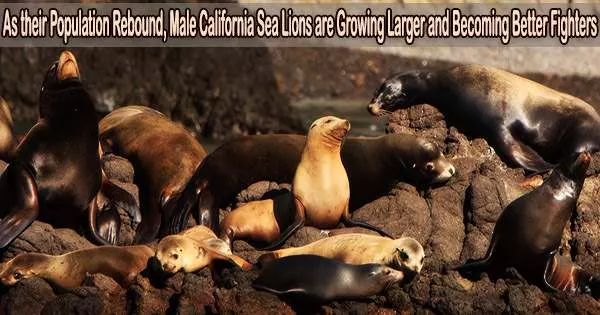As their number increases and the fight for food intensifies, California sea lions have been able to keep their average body size the same or even increased in the case of the males. In contrast, the average body size of other marine animals tends to decline as their population grows.
Researchers report on April 27, 2023, in the journal Current Biology that sexual selection was a strong driving force for males to grow bigger and to strengthen muscles in their neck and jaw that help them fight for mates. By changing their diets and, in certain circumstances, foraging farther from the beach, both male and female sea lions were able to avoid food shortages.
“Body size reduction is not the universal response to population increase in marine predators,” says lead author Ana Valenzuela-Toro, a paleoecologist at the University of California Santa Cruz and the Smithsonian Institution. “California sea lions were very resilient over the decades that we sampled and were able to overcome increasing competition thanks to prey availability. They’re like the raccoons of the sea: they can consume almost everything, and they can compensate if something is lacking.”
While many marine mammal species have rebounded to some extent since the Marine Mammal Protection Act was passed in 1972, California sea lions are notable for the size and duration of their population increase: the number of breeding females, who have been most consistently counted, has more than tripled in the US since the 1970’s from around 50,000 to nearly 170,000 and their population growth is only now beginning to plateau.
The researchers examined museum specimens of adult male and female California sea lions gathered in central and northern California between 1962 and 2008 to investigate how the ecology of these animals has altered as their population has increased.
They analyzed the total sizes of more than 300 sea lion skulls gathered throughout time in order to assess variations in body size. In order to evaluate changes in sea lion neck flexibility and biting force, they also evaluated other skull traits, such as the size of muscle attachment sites.
California sea lions were very resilient over the decades that we sampled and were able to overcome increasing competition thanks to prey availability. They’re like the raccoons of the sea: they can consume almost everything, and they can compensate if something is lacking.
Ana Valenzuela-Toro
In order to draw conclusions about the sea lions’ habitat and diet, the team also extracted microscopic bone samples from three of the skulls and examined their stable carbon and nitrogen isotope makeup.
“Carbon provides information about habitat use whether they’re foraging along the coast or offshore and nitrogen provides insights about the trophic level of their prey, for example if they’re consuming smaller or larger fish,” says Valenzuela-Toro.
Overall, the scientists discovered that the size of male sea lions has increased while the size of female sea lions has stayed constant. This gender disparity is likely caused by the fact that size influences male mating success but not female mating success.
“One male can breed with many females, and males in the breeding colony fight with each other to establish their territory,” says Valenzuela-Toro. “Bigger males are more competitive during physical fights, and they can go longer without eating, so they can stay and defend their territory for longer.”
Male sea lions also increased their biting force and neck flexibility over this same time period.
“The neck muscles are really important because they allow them to move their head and neck more agilely, bite harder, and, eventually, win when they are fighting other males in the breeding colony,” says Valenzuela-Toro.
According to the isotopic studies, both male and female sea lions were able to satiate their appetites by varying their diet and consuming a wider variety of prey. Male sea lions also foraged further afield.
“Over time, some male sea lions were foraging further north,” says Valenzuela-Toro. “This is consistent with some anecdotal records that they’ve even been seen in Alaska, where they were not known to go in the past.”
Female sea lions consistently had a more diverse diet compared to male sea lions. According to the authors, females were able to retain their average body size without moving closer to their food source because of their flexibility in food selection.
“They remain in a narrow zone around their breeding colony, but they still show a lot of flexibility in what they eat,” says Valenzuela-Toro. “We believe that skull morphology in the rostrum which is related to the size and shape of the mouth probably has something to do with this flexible foraging behavior. We found that the size and shape of the mouth of females is related to the size of the prey that they consume.”
However, this flexibility in diet can only take the sea lions so far, and the authors warn that the sea lions’ future may not be so rosy.
“All these dynamics occurred in an environment that was rich in prey: full of anchovies and sardines, two species that are super important for their diet,” says Valenzuela-Toro. “But over the last few years, the populations of these two fish have collapsed, so California sea lions are diversifying their diet to compensate, and apparently they are not doing so well.”
“As climate change progresses, prey availability of sardines and anchovies will decrease even more, and eventually we will have more permanent El Niño-like warming conditions, reducing the size and causing a poleward shift of these and other pelagic fishes,” she says. “It will be a really hostile environment for California sea lions, and eventually we expect that their population size will stop growing and actually decline.”





